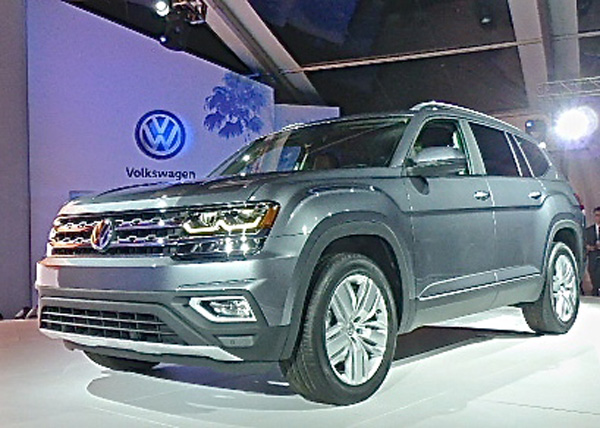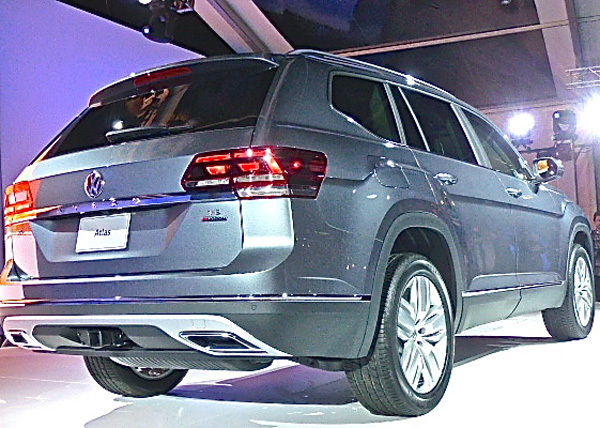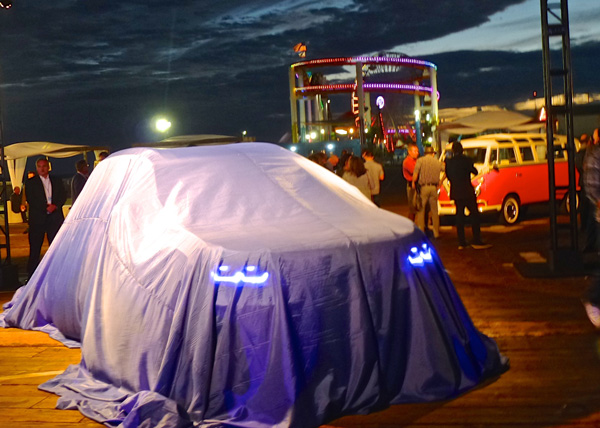News & Articles
Browse all content by date.

As Volkswagen stirs and juggles executives in the wake of its incredible diesel emission-cheating scandal, the company continues to make bold and aggressive moves to keep and even attract customers. The latest moves have been toward the cinch segment of sport-utility vehicles.
Volkswagen has restructured the popular SportWagen in recent years, and while maintaining it among Golf models now, instead of Jetta, VW also has reinforced it significantly and placed it on the market as its new Alltrack. Having tested the vehicle in the Pacific Northwest, I can attest to how impressive it is with its 4Motion system carrying its new and stiffer frame on some serious offroad trails.
Right on the heels of the Alltrack, Volkswagen invited selected automotive journalists to come out to Santa Monica, California, where we went out to an enclosed facility built on the legendary Santa Monica Pier and saw the unveiling of the Atlas – another new and larger SUV.
The Atlas is the largest SUV Volkswagen has ever built. It is, officially, a midsize SUV, which differentiates it significantly from the popular compact crossover trend. It is 198.3 inches long, 77.9 inches wide, and 69.6 inches tall.
“It is designed for American buyers and will be built at our American factory in Chattanooga, Tennessee,” said Hinrich Woebcken, CEO of VW Group of America. “We are adding $900 million to our factory, and that will help with our impressive electrification program. We intend to have 30 electirified vehicles by 2025.”
The Volkswagen Atlas will, Woebcken said, “offer a feeling of strength and presence, with full seven-seat capability. Our second-row seats will allow easy fit of child safety seats, and we think we have the best access to a third row of any SUV. And it’s lots of fun to drive.”

That would be a carryover characteristic of all Volkswagen vehicles, which always have had a secure handling feel to the suspension and steering, and a sportiness to the engines with built-in fuel efficiency.
Of course, missing in the equation is the always dependable VW turbo-diesel arsenal, all of which have been eliminated from sales, and even sales consideration, in the U.S. It goes back, of course, to the trick Volkswagen pulled to design an emission control system that would operate in full whenever tested for emissions, but would restrict some of the emission devices when not being tested, resulting in a bit more power and a bit better fuel economy. When it was detected, nobody in the auto industry could believe the extent Volkswagen went to hide the system, disguise it, and appear surprised by it.
Several top executives have lost their jobs in the aftermath, and the word now is that the popular turbo-diesel powerplants – known for being 300,000-mile type durable and 45-50 miles per gallon fuel efficient – would cease to exist as far as the U.S. is concerned. Volkswagen TDI owners are now getting their vehicles bought back by the company, because no efficient fix seems to be coming.
So there won’t be any turbo-diesels in the new Atlas, or in the new Alltrack for that matter. Fortunately for VW, its gasoline engines are all of the highest order right now, and their fuel economy has been increased where it actually is competitive with the exceptional turbo-diesel levels. The SUV-style vehicles won’t get that sort of fuel economy, but it should do well.

The Atlas, listed as a 2018 model, won’t reach dealerships until after the first of the year. As a large and strucurally sound vehicle, it will require some power to move it, and that power will come from either a 2.0-liter turbocharged 4-cylinder with 238 horsepower, or the somewhat legendary 3.6-liter VR6, with 280 horsepower. The VR6 has been a mainstay of VW for decades, although of course it has been upgraded to modern technology.
A normal V6 has three cylinders firing up at angles opposite each other, driven by the same crankshaft at the bottom; in the VR6, the two banks of cylinders actually alternate in location to facilitate the narrowness required to allow the cylinders to all be covered by the same cylinder head. The engine has always been sufficiently powerful and deliver adequate fuel economy.
In the Atlas, the 4-cylinder turbo will only be sold with front-wheel drive, while the VR6 will be available either with front-wheel drive or all-wheel drive – the aforementioned 4Motion system.
Both will be governed by an 8-speed dual-clutch transmission, which is a clutchless manual that shifts via two transmission cases, each operating alternating gears – first, third, fifth and seventh are shifted by one clutch, while second, fourth, sixth and eighth are shifted by another.

The digital cockpit display is designed within a clean interior – Woebcken calls it “elegant” – and the A pillars along the leading edge of the front doors is designed very thin to aid visibility. Digital connectivity is important to the company, and it will include Apple CarPlay, Android Auto, and Mirror Link, standard, and an optional Fender audio system with 480 watts and eight speakers.
“We are making a brand new journey into the heart of the U.S, market,” Woebcken said, noting that the Atlas, which will hit dealerships next spring, will compete with the Ford Explorer, Honda Pilot and Toyota Highlander as its primary target.
While the Atlas has a tall and somewhat blunt look, Darryl Harrison from VW’s marketing oversight, said, “It will be between the Touareg and Tiguan in size. It comes on the MQB platform, which is scalable, coming on the new Golf, and soon to come on the new Jetta and Passat.”
Wheelbase is 108 inches, which makes a rigid platform, better for durability, and VW always has been adept at making firm-handling vehicles feel supple enough to confront road hazards.
The rows of seating are in a 2-3-2 configuration, with the middle second-row seat fixed, but the outside seats capable of sliding fore and aft independently for occupant comfort but also to allow easier access to the third row.

The Alltrack, for practical purposes, doesn’t look much different from the SportWagen, although it is reinforced considerably, and it is not only rock-solid on the highway, but will do a fair impersonation of a mountain goat whenever you’re tempted to go off-road.
With the Touareg and the compact Tiguan, the Alltrack slides under both, being more of a more-rugged Sportwagen. Lighter and more agile than we can suppose the so-far static display Atlas, the Alltrack also rides on the MQB platform and is powered by the 1.8-liter turbo 4, with fifth generation 4Motion all-wheel drive, which has an electro-hydraulic clutch-pack differential.
With Alltrack models starting in the mid-$20,000 range, the yet-undisclosed Atlas pricing will undoubtedly be mid-$30,000.
As a dedicated fan of compact crossover SUVs (CUVs), I am partial to the Alltrack as a lower and more agile version of even a CUV, although it is a couple of inches taller for ground clearance than the SportWagen.
With the rush of 1.8, 2.0, and 3.6 engines, Volkswagen also is introducing a new 1.4-liter turbo 4-cylinder in the Jetta only for the new model year, but it is quick and fuel-efficient, and comes from a newer more high-tech family than the long-running 2.0 or its 1.8 derivative.
All of those engines, performing so well and so fuel-efficiently, it almost makes you forget all about the late, lamented turbo-diesel.
| Tweet |


